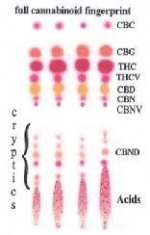Testing medical marijuana strains
Possible presence of cannabinoids in medical marijuana
So far 66 cannabinoids have been discovered and named in medical marijuana. There are most likely a dozen or more  cannabinoids present in medical marijuana, the so-called cryptics. Depending on what chromatograph you use you can distinguish 4 to 8 cannabinoids. Gas Chromatography Mass Spectometry (GC/MS) can discern 4 cannabinoids, whilst HPTLC (High Performance Thin Layer Chromatography) or HPLC (High Performance Liquid Chromatography) can quantify up to 8 cannabinoids.
cannabinoids present in medical marijuana, the so-called cryptics. Depending on what chromatograph you use you can distinguish 4 to 8 cannabinoids. Gas Chromatography Mass Spectometry (GC/MS) can discern 4 cannabinoids, whilst HPTLC (High Performance Thin Layer Chromatography) or HPLC (High Performance Liquid Chromatography) can quantify up to 8 cannabinoids.
HPTLC test to discern cannabinoïds for medical marijuana use
Recently we had two of our medical marijuana strains testing on the presence of cannabinoids using the HPTLC method. This method is currently the most advanced method available on the market. With this method you can check for cannabinoids, calculate percentages based on the readings of those cannabinoids and determine ratios between the separate cannabinoids. With these readings and these ratios you can give essential information to medical marijuana patients. Research over the years on cannabinoids separately and how two or more cannabinoids work synergistically allows to map the Medical Benefits of Marijuana. This allows us to relay the therapeutic benefits of each strain to Medical Marijuana patients. Everyone who Uses Marijuana Medical Reasons can look at the testresults of each strain of medical Marijuana to decide what strains works the best for him or for her.
Medical Marijuana in the US
When it comes to Medical Marijuana America and Canada is at the forefront of studies and trials being carried out. These studies and trials provide highly valuable information on the use of medical marijuana. This information provides medical caregivers what strains of Medical Marijuana to grow so they can cater for specific medical marijuana needs. These Medical caregivers operate using a medical Marijuana licence that allows them to care for an X amount of plants for an X amount of patients. These patients will have specific Marijuana Medical Purpose. Medical Dispensaries will advise patients on what strain to use for their ailment.
Results of selection and crossing of Medical Marijuana strains.
The scientist from the testlab could also, based on the cannabinoid fingerprint composed of 8 said cannabinoids, determine what chemotype the particular strain was. Remarkable outcome was that both Snow White and Bubblegun were, based on the present cannabinoids and their respective ratios, Sativa Dominant strains with clear Indica characteristics. Certainly with the Snow White we expected the outcome to be an Indica Dominant strain. The characteristics of the Snow White are predominantly Indica, such as; flowering period (short), scent, length (short), structure (short and bushy), color (darkgreen) and leaf shape (short, fat and ovalshaped). This just shows that we also incline more towards selecting the Indica dominant phenos as parents. Over all these years all the big indoor hits have been Sativa dominant strains, like Power Plant and White Widow, crossed with Indica strains to make them more compact, limit height and to shorten flowering period yet preserving all these wonderful Indica traits. These traits have been successful thanks to their Sativa genes, displayed in their scent, flavour (sweet and fruity), budstructure (halfopen en long candles), high (racy head high) and their high THC percentages.
Short explanation of cannabinoids to clarify test results of medical marijuana
To clarify the forthcoming test results (check our blog regularly!) of the Snow White and the Bubblegun, here’s a brief explanation of the cannabinoids and their synergistic effects. As we mentioned earlier the tests show 8 cannabinoids: THC, CBN, CBG, CBD, CBDV, THCV, CBC and the so-called cryptics.
Cannabinoids in medical marijuana; THC
THC stands for TetraHydroCannabinol and is the principal active component, along with CBD, of medical marijuana. THC is psycho-active and thanks to its medicinal properties has been studied for over 40 years. Research has shown that THC contains many medicinal properties and can be used therapeutically for a vast number of problems. THC mimics anandamide, a endogenous (within the body) neurotransmitter. This transmitter plays a vital role in the sensation of hunger, depression, memory, fertility and pain. THC attaches itself to CB1 receptors within the brain and that’s how THC plays a vital part within the endocannabinoid system of the body. If you’d like to find out how cannabinoids active or dim these CB receptors you can find more info in my blogtext ‘Medical Marijuana’. In short, THC works well subduing mild pain, THC relaxes your body, muscles, acts as an appetite stimulant and helps you with insomnia.
Cannabinoids in medical marijuana; CBN
CBN is the abbreviation for Cannabinol, which is a metabolite of THC. Therefore it is mildly psycho-active. The longer you store Cannabis the more the THC percentage will drop as it degrades and turns into CBN. CBN acts as a mild agonist of the CB1 receptors, but is clearly more of an agonist of the CB2 receptors. An agonist is a chemical substance that binds to a receptor of a cell and causes a reaction. CBN is not narcotic and has mild analgesic properties. CBN in medical marijuana greatly helps the body relax. A recent study strongly suggests that CBN’s anti-bacterial properties helps alleviate Psoriasis.
<h#>Cannabinoids in medical marijuana; CBG
Both THC and CBD share the same precursor, CBG. CBG is either transformed into CBD or THC and that’s why in the latter stages of flowering you will only find low concentrations of CBG in plant matter. CBG is non psycho-active and diminishes the psycho-active effects of THC, thus working as an antagonist of THC. A high percentage of CBG will relieve pain with IBS (Irritable Bowel Syndrome). Research has shown that CBG has an even more potent analgesic effect than THC. CBG also relieves intraocular pressure common with Glaucoma. It also proves to be an excellent remedy for erythema, better still than THC. Erythema is the reddening of the skin as a result of immunological or inflammatory responses of the body. If a medical marijuana strain contains more than 0,3{2b4a1a3f3bbc9c5a43771f34362679a3afcf9df24c0d9f4fe2fa80a69d802033} CBG you can assume it is an indica dominant strain. Amnesia (originally of Sativa dominance) is a fine example of hybrid turned into an Indica dominant strain (chemotype: CBG-Haze). Whilst most breeders will say it is a Sativa dominant strain with definite Indica traits. The average Amnesia has shown a CBG of between 0,5-0,6{2b4a1a3f3bbc9c5a43771f34362679a3afcf9df24c0d9f4fe2fa80a69d802033}, showing that it is clearly an Indica dominant strain.
Cannabinoids in medical marijuana; CBD
Cannabidiol is the other principal component of medical marijuana, after THC. I have thoroughly explained CBD and its medicinal properties in our blogtext Medical Marijuana, so if you want to find out more please check that out. CBD is, as CBG, an antagonist of THC dimming the psycho-active effects of THC. CBD is predominantly found in Indica dominant strains, such as Kush strains. A great number of studies in the last ten years have uncovered that CBD holds a vast array of therapeutical properties. Most notably it is famed for its anti-inflammatory and analgesic properties greatly helping to relieve pain. CBD is especially helpful with chronic pain as a result of muscle spasms, convulsions and inflammation, common with diseases, such as: MS, Fibromyalgia and epilepsy.
Cannabinoids in medical marijuana: CBDV
Cannabidivarin (CBDV) is found in higher concentrations in Indica Landraces that are found in Northwestern India and Nepal. CBDV is not psycho-active and stems from the same ancestral gene as CBD. Research has shown that it constrains the onset of a convulsion (epilepsy episode). It dims the intensity of such an epilepsy attack and those have the negative side-effects common with regular medication, such as tremors.
Cannabinoïds in medical marijuana: THCV
Another cannabinoid that can be measured is TetraHydroCannabiVarin (THCV). THCV is the homologue of THC thus stemming from the same ancestral gene as THC. THCV is predominantly found in landraces from South-East Asia, mainly in countries such as; Thailand, Cambodia and Vietnam. THCV is not psycho-active and works in lower dosage as an antagonist of THC, dimming the psycho-active effects of THC. THCV works as anti-oxidative. Whereby it limits the onset of cells destruction by the hands of free radicals. One of the many benefits working as an anti-oxidative that it slows down the aging process of the skin. THCV can activate the CB2 receptor and block the CB1 receptor. Several studies on THCV separately and its interaction with other cannabinoids have yielded promising results and have led to more research. It appears, for instance, that THCV takes away the aversion for food with Anorexic patients and even helps improve appetite. There are also strong indications that THCV stimulates bone growth. And more recent study strongly suggests that THCV proves to helpful as anti-inflammatory agent with auto-immune diseases. With auto-immune diseases, such as Diabetes Mellitus and Crohn’s Disease, your body creates immune responses and attacks its own cells and tissue as they are being considered alien. Result is an inflammation of cells, tissues and even organs. Animal tests have shown that THCV also helps alleviate symptoms of Parkinson’s and helps slow down the neurodegenerative aspect (onset and worsening of the disease) of Parkinson’s. Last but not least, THCV helps dim down the intensity of an epileptic episode.
Cannabinoïds in medical marijuana: CBC
CannaBiChromene (CBC) is more toxic than THC and has anti-inflammatory and anti-microbial properties. She is als slightly analgesic. CBC is also mildly sedative and helps relaxe. Research has shown that CBC also has anti-depressive properties, 10 fold of CBD. CBC is not pyscho-active and its content in medical cannabis is almost always less than 1{2b4a1a3f3bbc9c5a43771f34362679a3afcf9df24c0d9f4fe2fa80a69d802033}. There is a patent pending on an ant-epileptic medicine based on CBDV, CBD and THCV.
(c) Latest blog entries – Spliff and Marihuana Seeds – Read entire story here.


